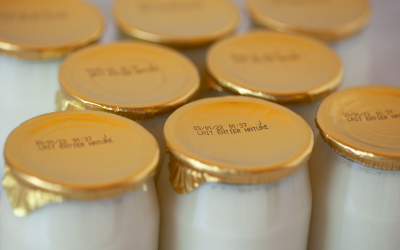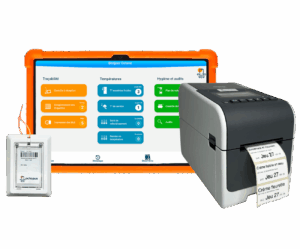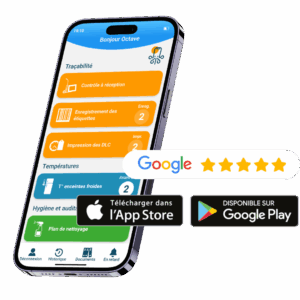DLC tracking chart for foodservice
Traçabilité
⏳ Temps de lecture : 5 min
? Mis à jour le : 19/11/2024
This article examines the various expiration dates required for different product types and the systems needed to maintain compliance, including expiration date tracking charts for foodservice, digital secondary expiration labeling, label printing solutions, etc. ?️
Critical Dates to Monitor in Foodservice ⏳
Effective food inventory management depends on maintaining traceability throughout product lifecycles according to labeled expiration dates (use-by dates, secondary expiration dates, best-before dates, use-until dates, and recommended consumption dates). Compliance with these parameters is mandatory under HACCP regulations for foodservice and ensures product quality for consumers.
What Does Use-By Date (DLC) Mean? ?️
Food products requiring use-by dates are typically refrigerated items: fresh meat, deli meats, prepared refrigerated meals, etc. Unpackaged products like fruits and vegetables, vinegars, and bakery items are exempt from use-by date requirements. ? ?
The secondary use-by date indicates the new expiration date for opened products. Note that a secondary use-by date can never exceed the original expiration date. When incorporated into prepared dishes, the closest secondary use-by date determines the expiration date for the final product.
The publication of a use-by date tracking table for catering, established in your Sanitary Control Plan (SCP), will serve as a reference to manage the lifespan of your products and optimize your inventory while ensuring the food safety of your customers. ✅
What is the definition of Best Before Date (BBD) and Use-By Date (UBD)?
When a product passes the best before date indicated on its packaging, it does not pose a health risk. However, its taste and nutritional qualities may deteriorate.
If this category of food is incorporated into a preparation with products having a use-by date, a secondary use-by date label must be issued for the preparation, set according to the use-by date of the perishable product. ⏳
The best before date of a product is indicated on its packaging: “Best before…” followed by a date (day/month, month/year, or year) or specifying the location on the packaging where it is indicated.
What about the Recommended Consumption Date (RCD)?
The RCD is the “recommended consumption date.” It corresponds to the best before date. For example, the RCD for eggs is 28 days. They can still be consumed several weeks if stored under normal conditions and if their shell is intact. However, a preparation made with raw eggs will have a very short use-by date (24 hours). The use-by date tracking table for catering specifies the secondary use-by dates for eggs after shell removal or incorporation into a preparation (homemade mayonnaise, pancake batter, etc.).
Tools to support you daily
Use-by date tracking table for catering, available for download
The use-by date tracking table for catering is a tool indicating the usual secondary use-by dates by product category:
- Fresh dessert: Day + 2
- Raw seafood: Day + 1
- Mayonnaise: Day 0
- Minced meat: Day + 1, etc.
The use-by date tracking table for catering is available for download, along with the fridge temperature monitoring sheets.
To download the document, please fill out the form below:
Octopus HACCP, digital management application for your use-by dates compliant with HACCP regulations
 Octopus HACCP is a simple and efficient digital application for managing your collective or commercial catering activity. Developed based on the HACCP method, it offers intuitive features adapted for data entry on mobile and tablet devices related to your activity (restaurants, food trades, collective catering, etc.).
Octopus HACCP is a simple and efficient digital application for managing your collective or commercial catering activity. Developed based on the HACCP method, it offers intuitive features adapted for data entry on mobile and tablet devices related to your activity (restaurants, food trades, collective catering, etc.).
For traceability and management of use-by dates and secondary use-by dates for your opened food products or those incorporated in preparations, the Octopus HACCP application automatically calculates your new use-by dates and generates printable labels with our connected Bluetooth printer. You just need to stick them on the packaging of opened or processed goods. The labels are guaranteed residue-free when removed and resistant to freezing.
The following information appears on the labels:
- Product name;
- Batch number;
- Product opening date and its use-by date;
- Sanitary stamp;
- Freezing date.
FAQ
How to manage use-by dates (UBD)?
Management of use-by dates and secondary use-by dates must be done in accordance with the HACCP method. You can refer to the use-by date tracking table for catering or manage your product use-by dates with the Octopus HACCP application. The use-by date of your products is recorded upon receipt in stock, then automatically reassessed when the product is opened or incorporated into a preparation. A secondary use-by date is generated, and new labels are then printed.



